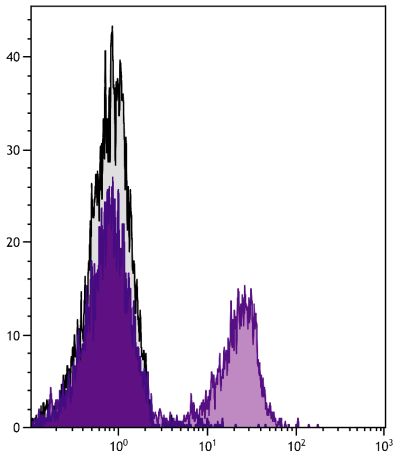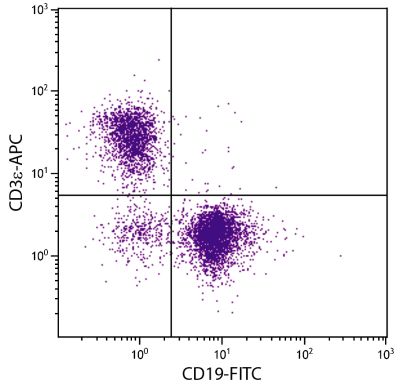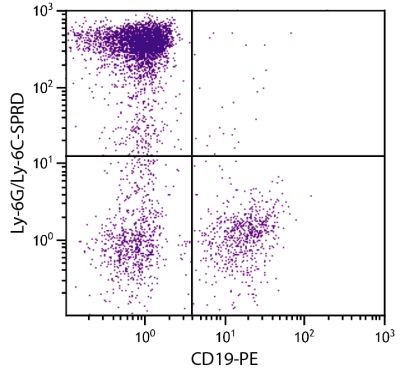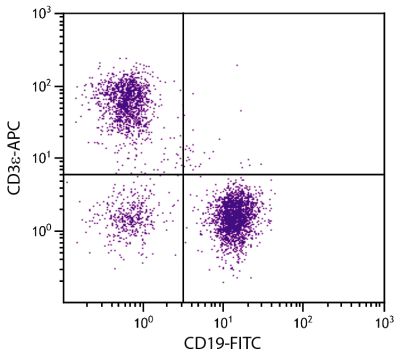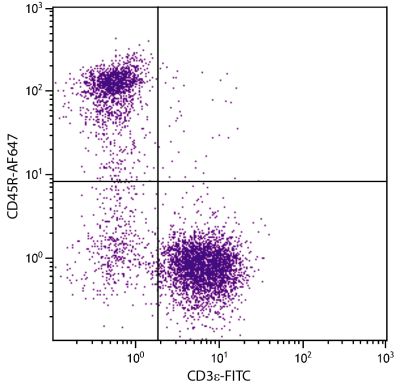Hamster Anti-Mouse CD3ε-APC (145-2C11)
Cat. No.:
1530-11
APC Anti-Mouse CD3 epsilon antibody for use in flow cytometry assays.
$212.00
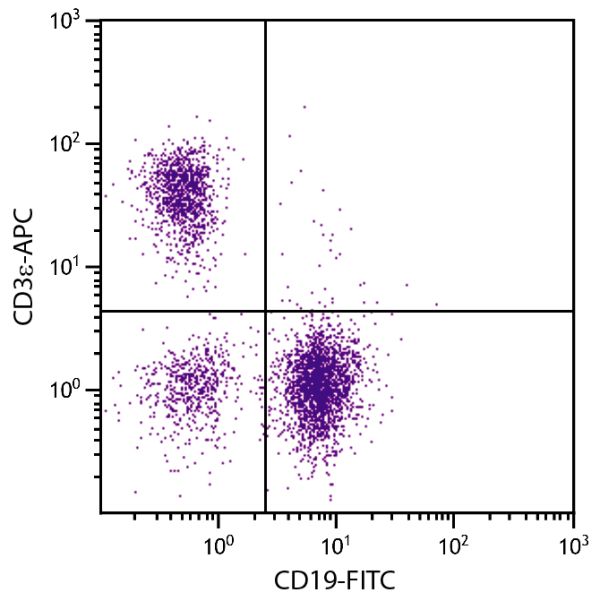


| Clone | 145-2C11 |
|---|---|
| Isotype | Hamster (Armenian) IgG1 |
| Isotype Control | Hamster IgG-APC |
| Specificity | Mouse CD3ε |
| Alternative Names | CD3 epsilon |
| Description | CD3ε, a member of the immunoglobulin superfamily of cell surface receptors, is comprised of five invariable chains ranging in size from 16-28 kDa and is closely associated with the T cell antigen receptor (TCR). It is expressed on all T cells of all mouse strains. CD3 plays a major role in signaling during antigen recognition, leading to T-cell activation. The 145-2C11 monoclonal antibody recognizes an epitope on the 25 kDa ε chain of the CD3/TCR complex. In the presence of Fc receptor-bearing accessory cells, soluble 145-2C11 can activate primed and naïve T cell in vitro. 145-2C11 can also induce redirected lysis of specific target cells by CTL clones and it can block lysis of specific target cells by antigen-specific CTL’s. Immobilized 145-2C11 can activate both normal T lymphocytes and cloned T cell lines. Under certain conditions, T cell activation by 145-2C11 may result in apoptotic cell death. |
| Immunogen | H-2Kb-specific murine cytotoxic T-lymphocyte (CTL) clone BM10-37 |
| Conjugate | APC (Allophycocyanin) |
| Buffer Formulation | Phosphate buffered saline containing < 0.1% sodium azide and a stabilizer |
| Clonality | Monoclonal |
| Concentration | 0.1 mg/mL |
| Volume | 1.0 mL |
| Recommended Storage | 2-8°C; Avoid exposure to light; Do not freeze |
| Applications |
Flow Cytometry – Quality tested 1,10-12 Immunohistochemistry – Reported in literature 9 Immunoprecipitation – Reported in literature 1,8 Western Blot – Reported in literature 8 Blocking – Reported in literature 2,3 Depletion – Reported in literature 6 Activation – Reported in literature 1,4,7 Complement Mediated Cell Depletion – Reported in literature 5 |
| RRID Number | AB_2794803 |
| Gene ID |
12501 (Mouse) |
| Gene ID Symbol |
Cd3e (Mouse) |
| Gene ID Aliases | AI504783; CD3; CD3epsilon; T3e |
| UniProt ID |
P22646 (Mouse |
| UniProt Name |
CD3E_MOUSE (Mouse) |
Documentation
Certificate of Analysis Lookup
Enter the Catalog Number and Lot Number for the Certificate of Analysis you wish to view
- 1. Leo O, Foo M, Sachs DH, Samelson LE, Bluestone JA. Identification of a monoclonal antibody specific for a murine T3 polypeptide. Proc Natl Acad Sci USA. 1987;84:1374-78. (Immunogen, IP, Activ, FC)
- 2. Bai Y, Liu J, Wang Y, Honig S, Qin L, Boros P, et al. L-selectin-dependent lymphoid occupancy is required to induce alloantigen-specific tolerance. J Immunol. 2002;168:1579-89. (Block)
- 3. Vossen AC, Tibbe GJ, Kroos MJ, van de Winkel JG, Benner R, Savelkoul HF. Fc receptor binding of anti-CD3 monoclonal antibodies is not essential for immunosuppression, but triggers cytokine-related side effects. Eur J Immunol. 1995;25:1492-6. (Block)
- 4. Bergese S, Pelletier R, Vallera D, Widmer M, Orosz C. Regulation of endothelial VCAM-1 expression in murine cardiac grafts. Roles for TNF and IL4. Am J Pathol. 1995;146:989-98. (Activ)
- 5. Wagner DH, Hagman J, Linsley PS, Hodsdon W, Freed JH, Newell MK. Rescue of thymocytes from glucocorticoid-induced cell death mediated by CD28/CTLA-4 costimulatory interactions with B7-1/B7-2. J Exp Med. 1996;184:1631-38. (CMDM)
- 6. Han WR, Murray-Segal LJ, Gershenzon A, Zhang JG, Hodder AN, Pietersz GA, et al. Idarubicin-145-2C11-F(ab')2 promotes peripheral tolerance and reduces chronic vascular disease in mouse cardiac allografts. Transpl Immunol. 1999;7:207-13. (Depletion)
- 7. Silverio JC, Pereira IR, Cipitelli M, Vinagre NF, Rodrigues MM, Gazzinelli RT, et al. CD8+ T-cells expressing interferon gamma or perforin play antagonistic roles in heart injury in experimental Trypanosoma cruzi-elicited cardiomyopathy. PLoS Pathog. 2012;8(4):e1002645. (Activ)
- 8. Molnár E, Swamy M, Holzer M, Beck-Garcia K, Worch R, Thiele C, et al. Cholesterol and sphingomyelin drive ligand-independent T-cell antigen receptor nanoclustering. J Biol Chem. 2012;287:42664-74. (IP, WB)
- 9. Al-Falahi Y, Sand KL, Knudsen E, Damaj BB, Rolin J, Maghazachi AA. Splenic natural killer cell activity in two models of experimental neurodegenerative diseases. J Cell Mol Med. 2009;13:2693-703. (IHC)
- 10. Conrad ML, Davis WC, Koop BF. TCR and CD3 antibody cross-reactivity in 44 species. Cytometry. 2007;71A:925-33. (FC)
- 11. Bauler LD, Duckett CS, O'Riordan MX. XIAP regulates cytosol-specific innate immunity to Listeria infection. PLoS Pathog. 2008;4(8):e1000142. (FC)
- 12. Grodeland G, Mjaaland S, Roux KH, Fredriksen AB, Bogen B. DNA vaccine that targets hemagglutinin to MHC class II molecules rapidly induces antibody-mediated protection against influenza. J Immunol. 2013;191:3221-31. (FC, Grizzly Bear Reactivity)
See All References


